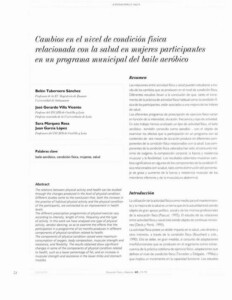Descripción
Introduction: The lack of research regarding nutrition, anthropometry and physical condition within the dance field in Peru is due to the fact that ballet is not considered a sportive activity, despite the increase of energy and nutrients requirements Therefore, this research pretends to be one of the first approaches to contribute to sportive nutrition. Purpose: Describe the association among diet, body composition and physical condition, especially for the dance of the National Superior Ballet School (ENSB) ballet students in Peru. Design: Observational descriptive-analytical crosswise study, carried out at the ENSB of Peru between October and December 2013. Materials and Methods: There were evaluated the anthropometry, nutrients consumption and physical condition of 60 students between 11 and 18 years old that belong to the Early Academic Training program (FAT) of the ENSB. An anthropometric protocol of 11 measures was applied to calculate the body composition indicators. The consumption of nutrients was evaluated through a 24-hour food diary survey, comparing it to the Dietary Recommended Intakes for energy, macro & micro nutrients. The aerobic condition was evaluated considering the maximum heart rate percentages (%MHR) obtained during the application of the Dance Specific Fitness Test (DSFT), and the explosive strength of the lower limbs was evaluated with the horizontal jump test and the percentiles jump/age for the Peruvian teenager population. The data was analyzed with the software STATA v.12.1® (StataCorp LP.TXT.USA). Results: Ballet students presented a deficit of Kcal (8.3%), fat (5%), vitamin E (3,3%), calcium (6,7%), carbohydrates (20%) and proteins consumption. There was an adequate consumption of iron (93,3%) and vitamin C (96,7%). The more adequate percentage for the consumption of proteins (r=-0,26; p=0,049), calcium (r=-0,31; p=0,015) and iron (r=-0,33; p=0,011), the less presence of total body fat mass. The more adequate percentage for the consumption of proteins(r=0,32; p=0,014), zinc (r=0,27; p=0,039), iron (r=0,34; p=0,009) and folic acid (r=0,33; p=0,011), the greater percentage of muscle mass. A relation between diet and physical condition was found, specifically between the iron consumption (r=-0,27; p=0,040) and the aerobic capacity. Conclusions: No significant associations were found between body composition and physical condition or between diet and lower limbs explosive strength; however there was found a significant relation between aerobic condition and body composition. These results require greater research involving ballet students, where biochemical and VO2 measurements are included.; Introducción: La ausencia de investigación en nutrición, antropometría y condición física, en el campo de la danza en el Perú, se debe a que el ballet no es considerado una actividad deportiva, a pesar del incremento del requerimiento de energía y nutrientes. Por ello, esta investigación pretende ser una de las primeras aproximaciones que contribuya en la nutrición deportiva. Objetivo: Describir la…




